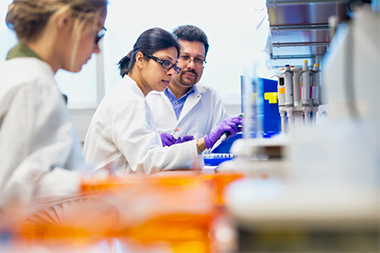RNA Scientists Advance Early Detection of Duchene Muscular Dystrophy
 |
|
Bijan Dey, at right, works pre-2020 in his lab with an RNA researcher and, at left, a student.
|
ALBANY, N.Y. (July 30, 2020) — The devastating effects of Duchene muscular dystrophy (DMD) can be mitigated if detection takes place in early childhood. Sadly, early diagnosis is rare. Now, University RNA researchers have discovered a novel method that could solve this long-standing problem.
The research team, from the UAlbany laboratories Professor Igor Lednev of Chemistry and Bijan Dey —a principal investigator of the RNA Institute and an associate faculty member of Biological Sciences, respectively— published its findings on July 16 in the journal Nature Scientific Reports. Their work promises a tool to improve the accuracy, ease and potential of an early diagnosis for DMD.
In the case of DMD, such timing is critical. “Despite certain limitations, the current treatment options provide patients with symptom relief and improved quality of life — if treated early,” said Dey, whose research program, funded by SUNY, the American Heart Association and the NIH, has a major goal of understanding the fundamental molecular mechanism of muscle development and devising devise new therapeutic and diagnostic platforms for DMD.
The full DMD research team, which also includes institute scientist Paromita Dey, PhD student Nicole Ralbovsky and undergraduate researcher Andrew Galfano, used mouse models and analyzed blood serum with Raman hyperspectroscopy, a technique that produced a specific fingerprint for each sample. Different samples were then distinguished, including dried traces of body fluids collected from healthy donors and donors with a disease.
By combining this technique with advanced statistical analyses, the researchers were able to build a model technique that identified differences in classes of samples to make accurate, early and minimally invasive diagnostic predictions.
The result achieved a 100 percent success rate in classifying the nornal and DMD mouse models.
DMD, a form of muscular dystrophy caused by a mutation in the Dystrophin gene, the largest known human gene, affects approximately one in 3,500 male births worldwide. It causes victims to have a progressive loss of skeletal muscle function, followed by severe muscle wasting and weakness. By age 12, most boys are confined to a wheelchair, with few individuals living beyond their 30s. Death most commonly comes from secondary causes, such as cardiomyopathy (enlarged heart) and breathing complications.
Ralbovsky, a fourth-year graduate student from the Lednev Lab and member of the institute’s RNA Fellows Program, was recently honored with two prestigious awards for her work on Raman Spectroscopy. She said the team’s diagnostic model may have far-reaching effects.
“This research really has great potential to revolutionize how we diagnose ailments, including DMD,” she said. “Current methods are focused on detecting a specific biomarker or two which can be present at very low concentrations during early stages of disease. Our method is incredibly advantageous because it probes the entire biochemical composition of the sample, giving us the ability to detect a disease earlier and more specifically than any other currently used method.”
Lednev noted that his lab is now working to advance this patented “universal method” to commercialization, supported by the SUNY Research Foundation and UAlbany Office for Research through the Technology Accelerator Fund program.
He praised the interdisciplinary nature of the DMD study. “The expertise of medical doctors, biochemists, spectroscopists and statisticians is required to conduct this work,” Lednev said. “We were fortunate that Drs. Bijan Dey and Paromita Dey teamed up with us to provide samples and invaluable expertise in DMD disease for this proof-of-concept study. Nicole Ralbovsky conducted the Raman hyperspectroscopy experiment with the assistance of undergraduate researcher Andrew Galfano.”
Andy Berglund, RNA Institute director, called the DMD study “exciting research that demonstrates the importance of an interdisciplinary team coming together to develop a potentially new diagnostic approach for a common form of muscular dystrophy.”
![]() For more news, subscribe to UAlbany's RSS headline feeds
For more news, subscribe to UAlbany's RSS headline feeds
A comprehensive public research university, the University at Albany-SUNY offers more than 120 undergraduate majors and minors and 125 master's, doctoral and graduate certificate programs. UAlbany is a leader among all New York State colleges and universities in such diverse fields as atmospheric and environmental sciences, business, education, public health,health sciences, criminal justice, emergency preparedness, engineering and applied sciences, informatics, public administration, social welfare and sociology, taught by an extensive roster of faculty experts. It also offers expanded academic and research opportunities for students through an affiliation with Albany Law School. With a curriculum enhanced by 600 study-abroad opportunities, UAlbany launches great careers.


